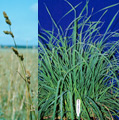Common Manitoba Hay Varieties
Manitoba produces some of the finest quality hay in the world. Fertile soils, long growing season and favourable climate make for ideal hay growing conditions. Manitoba’s ideal climate means that it is easy to put up mould free hay. Other insect pests are uncommon due to Manitoba’s very cold winters. It is the perfect scenario for buyers seeking quality forage products. The following forage varieties are commonly grown in Manitoba and make very good horse hay. They can be purchased as straight legume, grass or as mixtures.
Smooth Brome

The bromes are well adapted to Manitoba growing conditions. Smooth brome is a tall, soft leafy-stemmed grass that horses find very palatable. It is reasonably easy to cure and makes dark brown-green hay.
Orchard grass

Orchard grass makes very palatable soft hay that is a bright green in color. It is a leafy plant with few stems. It is grown in the moister areas of Manitoba and is generally used as pasture grass. It combines well with alfalfa and is often grown in a mixture.
Meadow Brome

Meadow Brome is generally used as a pasture grass as it has many basal leaves, few stems and good regrowth capabilities. However, it is often used as a hay grass as it combines well with alfalfa, not being as aggressive as smooth brome. Meadow brome cures into soft medium green leafy hay that horses find very palatable.
Intermediate wheatgrass

Intermediate wheatgrass is a tall growing forage with medium coarse leafy stems. It cures into medium green, dust free hay. It is palatable to horses and when harvested at later maturity PMU operators favour it.
Timothy

Timothy has long been a favourite hay for horses. It is easily cured into bright lime-green coloured hay that is dust free. It’s nutrient content is well suited as a mature horse diet. Stems and leaves are large but soft. Horses find the hay very palatable.
Crested wheatgrass

Crested wheatgrass is a fine stemmed, leafy grass. It is easily cured into medium green coloured hay that is dust free. When harvested in early head it is comparable in quality to other grass hays. Harvested after heading the quality declines and makes it a hay favoured by PMU (Pregnant Mares Urine) operators. Horses like crested wheatgrass but if harvested at late maturity the stems tend to be stiff and the hay is less palatable.
Alfalfa

Alfalfa is well adapted to Manitoba growing conditions. Alfalfa is very palatable and horses love it. It is reasonable easy to cure and makes a rich dark green coloured hay.
Alfalfa is generally higher in nutrients and energy than grass hay which makes it an ideal choice for horse owners with mares in late gestation, lactation, or growing foals. However, horses with lower nutritional needs may get fat on alfalfa and grass hay may be a better choice.
Varieties to Avoid
Alsike clover, sweet clover, silage, sorghum, sorghum-sudan grass hybrids or forages with large awns like barley green feed or canary seed.
